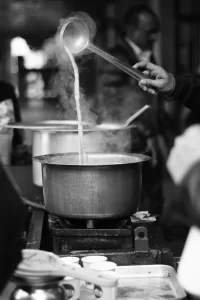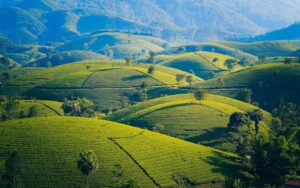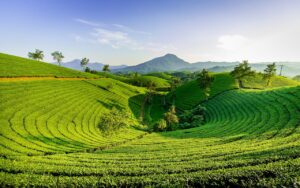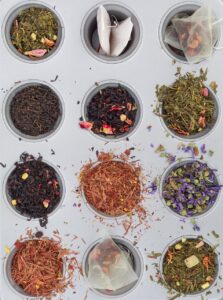Kenya Tea, Purple Tea Benefits, and Recipe

Uncover the secrets of Kenya tea, from its lush plantations to Best tea factories. Explore the diverse range of flavors and health benefits.
Nestled within the lush landscapes of Kenya lies a treasure that has captivated tea enthusiasts around the world for centuries. Kenya, renowned for its breathtaking savannas and diverse wildlife, is also celebrated for producing some of the finest teas on the globe. The story of Kenya tea is one steeped in rich history and cultural significance, from its humble beginnings to its rise as a powerhouse in the global tea industry.
The journey of Kenya tea begins with the country’s favorable climate, fertile soil, and high altitudes, which provide the perfect conditions for cultivating top-quality tea leaves. However, what truly sets Kenya apart is its unique processing method known as CTC, or crush-tear-curl, which yields a distinctively bold and robust flavor profile. As we embark on an exploration of Kenya’s illustrious tea heritage, we’ll uncover the intricate artistry behind this beloved beverage and gain insight into how it has become an integral part of Kenyan culture and identity. Join us as we delve into the captivating world of Kenya tea – where tradition meets innovation in every tantalizing sip.
History of Tea in Kenya
The history of tea in Kenya is a tale of cultivation, adaptation, and economic transformation. Here’s a snapshot of the tea journey in the Kenyan highlands:
1. Introduction of Tea: The roots of Kenya’s tea industry trace back to the early 20th century when British settlers, particularly one G.W.L. Caine, planted the first tea seeds in Limuru, near Nairobi, around 1903. This experimental tea planting was aimed at exploring the adaptability of tea to the Kenyan climate and soil.
2. Commercialization Begins: The commercial cultivation of tea in Kenya gained momentum in the 1920s. British companies like Brooke Bond and Williamson actively engaged in the tea business, realizing the favorable conditions for tea cultivation in Kenya. Large-scale plantations started to emerge.
3. Expansion and Diversification: The success of tea cultivation led to an expansion of plantations into different regions of Kenya, particularly the highlands. The climate and altitude in areas like Kericho, Nandi Hills, and Kiambu proved ideal for tea farming. As a result, tea estates multiplied, and Kenya’s tea industry diversified.
4. Smallholder Tea Farming: While large estates played a crucial role, the Kenyan government, recognizing the potential economic benefits, encouraged smallholder tea farming. The 1960s saw the establishment of the Kenya Tea Development Authority (KTDA), which facilitated small-scale tea growers, empowering local communities.
5. Rise of KTDA: The KTDA became a key player in the Kenyan tea landscape, promoting fair practices and ensuring that smallholders had access to markets. It assisted in the processing and marketing of tea produced by small farms, contributing significantly to Kenya’s tea exports.
6. Global Dominance: Kenya’s tea industry grew to become one of the leading producers and exporters globally. Kenyan tea, known for its briskness, brightness, and bold flavor, gained popularity in international markets. The country consistently ranks among the top tea-exporting nations.
7. Social and Economic Impact: The tea industry has played a pivotal role in Kenya’s economy. It has provided employment opportunities, especially in rural areas where tea plantations are located. Additionally, the revenue generated from tea exports has contributed significantly to the nation’s foreign exchange earnings.
8. Challenges and Innovations: Like any industry, Kenya’s tea sector has faced challenges, including fluctuating global prices and issues related to fair compensation for tea growers. However, continuous efforts in research, development, and sustainability practices have been implemented to address these challenges.
Today, Kenya stands as a major player in the global tea market, with tea being a vital part of its cultural and economic landscape. The journey from experimental plantings to a thriving industry reflects the resilience and adaptability that define Kenya’s tea story.
Kenyan Purple Tea: A Healthier Hue
Enter the world of purple tea, a distinct variety crafted from the leaves, buds, and shoots of a unique crossbreed within the Camellia Sinensis family—the same plant family responsible for the diverse range of teas, including black, green, yellow, white, and oolong. What sets purple tea apart? Its plant boasts a captivating purple-red hue, mirrored in the anthocyanins, antioxidants that tint this tea with a regal purple shade, akin to the allure of raspberries and purple grapes.
Purple Tea Benefits
1. Blood Sugar Control:
– Purple tea emerges as a formidable ally in managing blood sugar levels, acting as a preventative shield against diabetes.
2. Catechins for Weight Warriors:
– Rich in catechins, purple tea becomes a partner in the battle against body fat, aiding in weight loss endeavors.
3. Anti-Aging Elixir
– Unlocking the secrets of anti-aging, purple tea houses compounds that contribute to even skin tones, wrinkle reduction, and enhanced complexions. No wonder it’s a coveted ingredient in skincare formulations.
4. Guilt-Free Sips:
– With lower caffeine content compared to its black and green counterparts, along with minimal calories, purple tea invites you to sip without the baggage of excess stimulants.
5. Cancer-Fighting Essence:
– Believed to harbor antioxidants, purple tea stands guard against certain cancer forms—prostate, breast, and colon cancers—making it a health-conscious choice.
As you explore the vibrant world of teas, let purple tea take center stage, not just for its distinctive color but for the symphony of health benefits it brings to your cup.
Kenya Black Tea
Black Tea Unveiled
Black tea reigns supreme as the world’s most beloved tea, boasting an impressive 90% share of the global tea consumption landscape. Derived from the leaves and buds of the venerable Camellia Sinensis plant, black tea distinguishes itself through a comprehensive oxidization process, resulting in its distinctive and rich black hue – a testament to being the most processed tea variant.
Benefits of Black Tea

1. Antioxidant: Black tea stands as a bastion of antioxidants, particularly polyphenols, actively engaged in shielding body cells from potential DNA damage.
2. Caffeine Kick: The caffeine content in black tea doesn’t just make for a robust flavor; it also offers a mild yet effective stimulation of the brain, enhancing mental alertness and focus.
3. Cancer Combatant: The polyphenols within black tea wield their protective prowess, contributing to the prevention of certain cancer forms, including ovarian and prostate cancer.
4. Heart’s Guardian: Laden with flavonols, black tea becomes a heart ally, actively working to stave off the risk of heart diseases and maintaining cardiovascular well-being.
5. Digestive Dynamo: Thanks to its unique blend of chemicals and tannins, black tea takes on the role of a digestive maestro, promoting improved digestion and overall gastrointestinal health.
As you savor your cup of black tea, relish not only its bold flavor but also the myriad health benefits steeped within each comforting sip. Cheers to the reigning champion of teacups – the illustrious black tea!
Kenyan Tea Recipe

Ingredients:
– 2 cups water
– 2 teaspoons black tea leaves
– 1/4 cup milk
– Sugar to taste
Instructions:
1. Boil the water in a saucepan.
2. Add the black tea leaves and let it simmer for 3-5 minutes.
3. Stir in the milk and bring to a gentle boil.
4. Add sugar to taste, stir, and remove from heat.
5. Strain the tea into cups and serve hot.
Best Tea Factory in Kenya
Kenya boasts a plethora of tea factories, each contributing to the country’s robust tea industry. Here’s a glimpse into some of Kenya’s heavyweights in tea manufacturing. The list is extensive, reflecting only a fraction of the numerous tea factories scattered across the nation. If you set out to visit one factory every day, it would take an entire year to explore them all.
1. Ekaterra Tea Kenya PLC: Operates eight tea factories sprawled across Kericho County and Kiambu, including Chagaik, Jamji, Kericho, Kimari, Kimugu, Koruma, Tagabi in Kericho, and Mabroukie in Kiambu.
2. Finlays Kenya Ltd: Flaunts Changana, Chomogonday, Kitumbe, Koros, Kymulot, and Saosa Tea factories, all nestled within Kericho County.
3. Williamson Tea Kenya Ltd: Oversees four factories, three in Nandi County (Kapchorua, Changoi, Kaimosi) and one in Bomet (Changoi).
4. Eastern Produce Kenya Ltd: Owns an impressive count of seven tea factories, all residing in Nandi County, including Chemomi, Kepchomo, Kapsumbeiwa, Kibwari, Kipkoimet, Savani, and Siret.
5. Kaisugu Factories: Manages three factories—one in Kericho and two in Nakuru County, namely Kiptagich Tea Estates Ltd, Kaisugu Ltd, and Tachasis Tea Factory (Kiptagich Satellite).
6. Kipkebe Tea Factories: Operates two tea factories situated in Nyamira County, comprising Kipkebe and Keritor.
7. Sotik Tea Factories: Holds two tea factories in Kenya, namely Sotik Highlands Tea Estate Limited and Sotik Tea Company LTD.
8. Nyayo Tea Zones: Administers two tea factories: Kipchabo Tea Factory in Nandi and Gatitu Tea Factory in Nyayo (Kirinyaga).
9. D.L Factories: Manages DL Koisagat Tea Estate and D.L Kaptel T.F, boasting two tea factories in Kenya.
Remember, this rundown encapsulates some of Kenya’s major tea factories. The order does not denote any ranking. With numerous other factories sprinkled across Kenya, the tea landscape truly thrives in diversity and magnitude.
Photos of Tea





